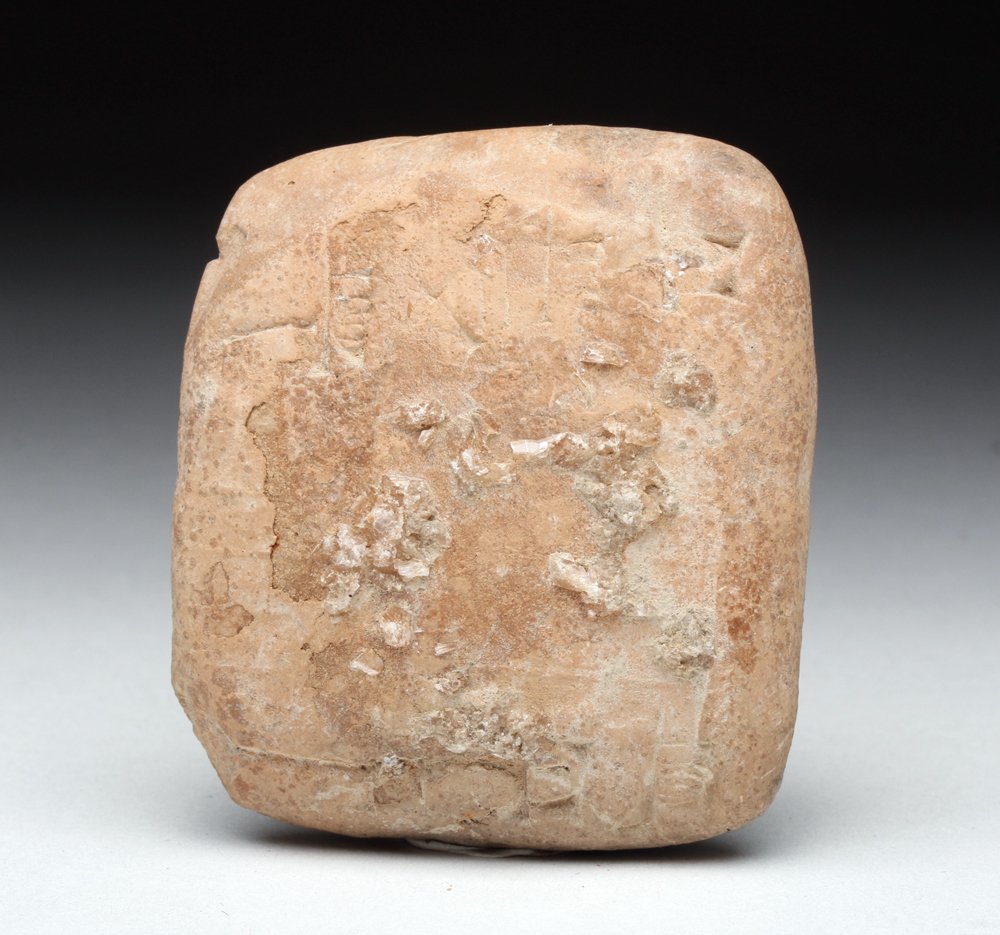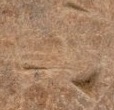 |
A 4,000 year old ‘delivery docket’. Reading from the bottom on the above (using modern volume equivalents):
“In the month of šugargal did Ur-Dumuzi receive from Ur-mes 16 litres of dried cheese with sumac and 13 litres of clarified butter.”
 |
As with the later Old Babylonian Tag in this collection, this is a receipt for goods from the Sumerian civilisation - the source of cuneiform script which was the earliest known alphabetic writing system. Cuneiform was developed in the period prior to 3,500 BC in the fertile plain of Mesopotamia between the Tigris and Euphrates rivers.
The tablet was obtained at auction at the Artemis Gallery (but also allowing bidding online) on 24 Sep 2015 having been held prior to that by Harlan J. Berk Ltd.
Ozaki Tohru, an expert on the period of this tablet has kindly provided some commentary on its context. He notes it is from an ancient Sumerian city called Urusagrig or Irisagrig (or Al-Sharraki in Akkadian).
Prof Tohru writes “The period was called the Ur III period (or the period of the Third Dynasty of Ur). This kingdom was powerful in the 21 century B.C. and its realm was mainly in the Southern part of present Iraq, approximately from the South of Baghdad until the head of the Persian Gulf. At that time there were many Sumerian cities where not only Sumerians but Semitic Akkadians lived. Urusagrig was one of them, but its exact position is still unknown. According to some recent studies man says it lay somewhere South rather than near today’s Iraqi capital.”
“On the reverse of the tablet we can read iti shu-gar-gal, the name of one of 12 months of the calendar used in that city. David Owen of Cornell University, a very famous and leading scholar of the Sumerian history, thinks that the month held the first position of a year, that is, it was the first month of a year (corresponding to March to April today). But through my new study, I have another opinion that it was the second. But my opinion is not published yet in a journal or a monograph --- indeed today I have completed an article about it —, many scholars do not have any doubt against Owen’s view.”1
The tablet constitutes a receipt signed by Ur-Dumuzi, who, as Bob Englund notes, was “presumably someone representing in some way a state agency in Irisagrig, from Ur-mes, who we may suspect deals with the processing or transportation of dairy products in some way. As soon as the “nice numbers” 5 and 7 1/2 go away, you are dealing with real things and not quotas.” The receipt is for the delivery of 13 litres of clarified butter and 16 litres of dried cheese with the herb sumac. On this receipt, the characters for 3 and 6 are clearly visible [see the second character group in lines 1 and 2].”
Translation
The following is a translation of the text of the front side of the tablet. The formal translation of each line was made by David Owen in 20132 and is shown with some elaboration by Bob Englund. The formal entry for this tablet can be found in the cdli database at this record (P454156).3
Below, the front face of the tablet is shown with Owen’s translation line by line and elucidated character by character for the first two lines. Additional additional explanation is provided, in particular drawn from the CDLI Wiki Neo Babylonian weights and measures section and papers by Bob Englund. The translation by Owen of the legible characters on the reverse face are also shown.
Front Face of Tablet
Line 1. 1(ban2) 3(disz) sila3 i3-nun (1 ban2 3 sila3 clarified butter)

 = 1 ban2 (approximately 10 litres)
= 1 ban2 (approximately 10 litres)  3 disz (3 vertical strokes = 3)
3 disz (3 vertical strokes = 3)
 1 sila3 (which is approximately equivalent to 1 litre )
1 sila3 (which is approximately equivalent to 1 litre ) stands for ghee = clarified butter.
stands for ghee = clarified butter. Translates as 1 [10 litre] + 3 x 1 [1 litre] (ie total of 10+3 = 13 litres) of clarified butter.
Note 1:
(ii) Thirteen litres of clarrified butter corresponds roughly to the rental (3–5 litre/cow) from the production of butter oil of 3 cows over a year 4
(ii) the issue of what each measure represents is complicated by the fact that in different periods the same unit could correspond to different quantities. Ozaki Tohru notes that this tablet belonged to the Ur III period. At that time 1 ban2 corresponded to 10 sila3, although in the Early Dynastic period 6 sila3 was 1 ban2. So for this tablet we may translate the line 1 ban2, 3 sila3 [of] i3-nun was 10+3 sila3 i3-nun, that is 13 liters of fine butter. (The equivalences were: 10 sila3 = 1 ban2, 6 ban2 = 1 nigida, 5 nigida = 1 gur, therefore 1 gur = 10×6x5 = 300 sila3 (ca. 300 liters)).5
Line 2. 1(ban2) 6(disz) sila3 ga gazi (1 ban2 6 sila3 kašk-cheese with sumac)
 1 ban2 (10 litres)
1 ban2 (10 litres)  6 disz (6 vertical strokes = 6)
6 disz (6 vertical strokes = 6) where 1 sila3 is approximately equivalent to 1 litre
where 1 sila3 is approximately equivalent to 1 litre  ga (dried cheese)
ga (dried cheese) gazi (with sumac -noting that the attribution of the herb gazi to the modern herb sumac is Bob Englund’s guess based on travelling in Iraq.)6
gazi (with sumac -noting that the attribution of the herb gazi to the modern herb sumac is Bob Englund’s guess based on travelling in Iraq.)6Translates as 1 [10 litre] + 6 x 1 [1 litre] (ie total of 10+6 = 16 litres) of dried cheese with sumac
Note: 16/1.7 kg = 9 kg of dried cheese, approximately (or a bit more than) the cheese production normally assumed from the milk of one cow for a year7 of kašk-cheese [ga] - dried cheese, which can be kept for years without spoiling.
Line 3. ki ur-mes-ta (from Ur-mes)
Bob Englund notes that ur-mes in Irisagrig is usually the governor (ensi2)
Line 4. ur-{d}dumu-zi (did Ur-Dumuzi)
Back Face of Tablet
Line 1. szu ba-ti (receive)
blank space
illegible seal impression
Line 2. iti szu-gar-gal (month “šugargal”)
Ozaki Tohru notes that šugargal is usually considered the first month of the year, but there is some evidence it may have been the second.
1 Ozaki Tohru, “On your tablet”, private communication, 2 Nov 2015 (↑)
2 David Owen, Nisaba 15: Unprovenanced Texts Primarily from Iri-Saĝrig/Āl-Šarrākī and the History of the Ur III Period, Volume I: Commentary and Indexes, 2013, 0987. (↑)
3 Bob Englund, “Re: Another Tablet”, private communication, 25 Sep 2015. (↑)
4 Robert K. Englund, Regulating Dairy Productivity in the Ur III Period, Commentationes, http://cdli.ucla.edu/staff/englund/publications/englund1995c.pdf, viewed 16 Nov 2015, p. 395 (↑)
5 Ozaki Tohru, “Re:Re: On your tablet”, private communication, 5 Nov 2015. (↑)
6 Englund, Regulating Dairy Productivity in the Ur III Period, p. 379 (↑)
7 Englund, Regulating Dairy Productivity in the Ur III Period, p. 383, 389 (↑)
Pages linked to this page
 This work by Jim Falk is licensed under a Creative Commons Attribution-NonCommercial-NoDerivs 3.0 Unported License Click on the logo to the left to see the terms on which you can use it.
This work by Jim Falk is licensed under a Creative Commons Attribution-NonCommercial-NoDerivs 3.0 Unported License Click on the logo to the left to see the terms on which you can use it.